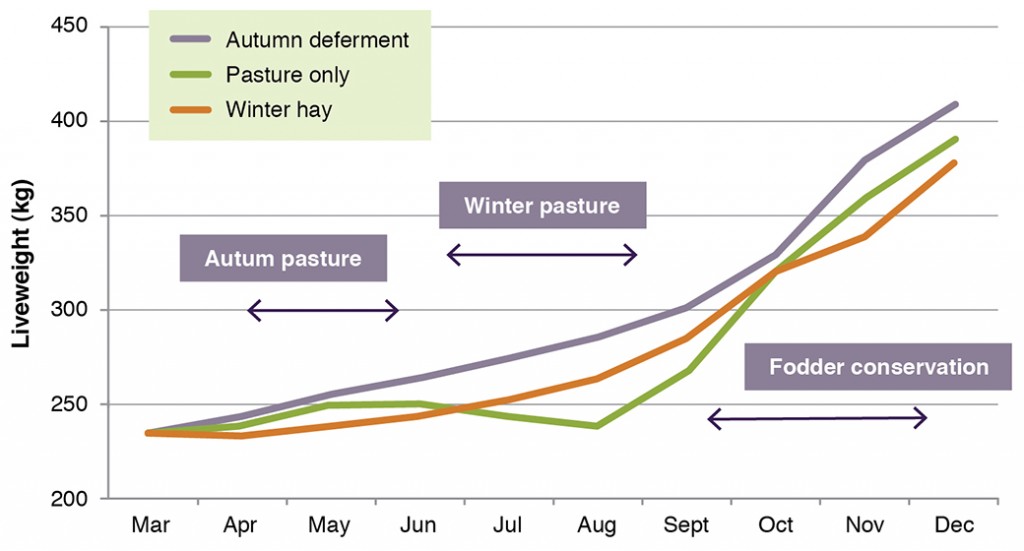Manage variable seasons
Tactical management to balance feed supply in variable seasons
Key points
- It is important to get the basics right (stocking rate, lambing, weaning, joining length) to minimize the imbalance between supply and demand.
- Plan ahead, consider likely pasture growth and feed demand and if there will be a surplus or deficit in the next three to four months.
- Consider strategies to use surplus pasture or generate more pasture well before it is needed.
- Tools such as the MLA Rainfall to pasture calculator, and the EverGraze Feedbase Planning and Budgetting Tools are available to help determine feed supply and demand and the most cost effective way to boost pasture growth.
- When feed shortages or excesses appear likely, consider all options rather than just supplementary feeding or fodder conservation.
- In tough seasons, beef cattle have a large requirement for supplementary feeding. Grain can be very cost effective compared to hay or silage provided its introduction and feeding is carefully managed.
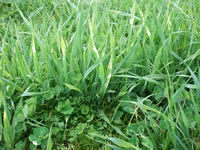
Introduction
Pasture growth varies between seasons and years. To make the most from a livestock system, the first step is to match overall feed demand with feed supply from pasture. Once this big picture item has been set, tactical management is about how to grow more or reduce demand in tough years and use more in good years.
The following information will set out the alternatives for southern Australian grazing systems.
Steps to matching feed supply and demand
1. Match stocking rate and time of lambing with seasonal production
The first consideration is to make sure that overall farm stocking rate and timing of reproduction matches seasonal pasture growth. While these are strategic decisions and cannot be easily changed between years, if the feed demand is out of sync with pasture growth, seasonal deficits and surpluses will be exacerbated. Look at your stocking rate and consider how the demand matches normal pasture growth.
Figures 1 and 2 show the feed demand and supply for two Merino flocks, autumn lambing compared with winter lambing. The key assumptions in the simulations are;
- Farm; 1300 ha with 200 ha of crop, grazed in summer and July.
- Pastures: 700 ha of good perennials, 300 ha degraded annual based pastures, 100 ha lucerne.
- Autumn lambing option; 3000 Merino ewes, 750 maiden ewes, 750 weaners, surplus lambs sold at weaning.
- Winter lambing option; 3500 Merino ewes, 875 maiden ewes, 875 weaners, surplus lambs sold at weaning. About 10% higher stocking rate on the winter lambing farm than on the autumn farm.
- Supplements were fed on both farms from February to June increasing from 3-5 kg/ha/day.
The feed demand is shown in the bar graphs, freshly grown pastures on offer is shown by the solid green line, total feed on offer by the light green line, and supplementary feeding by the red line.
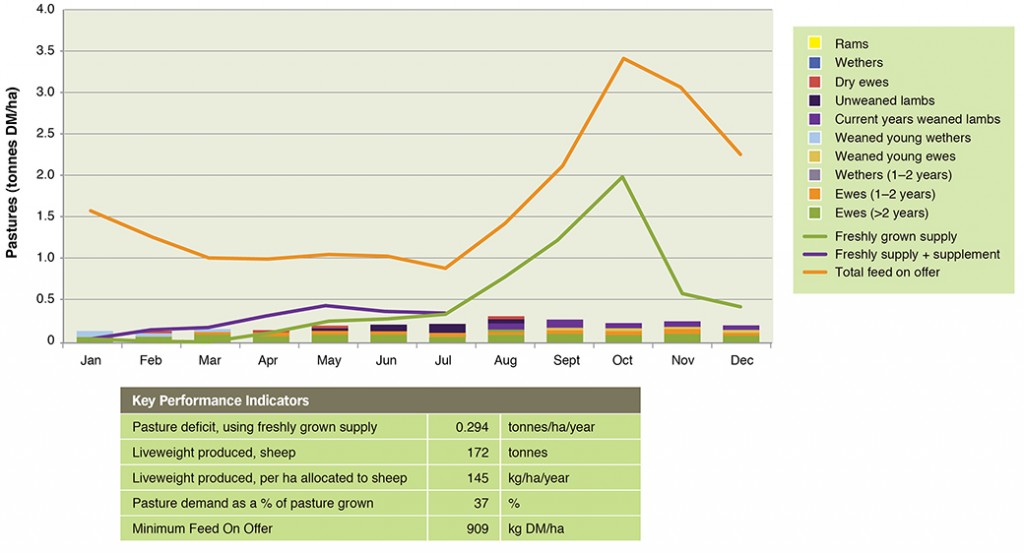
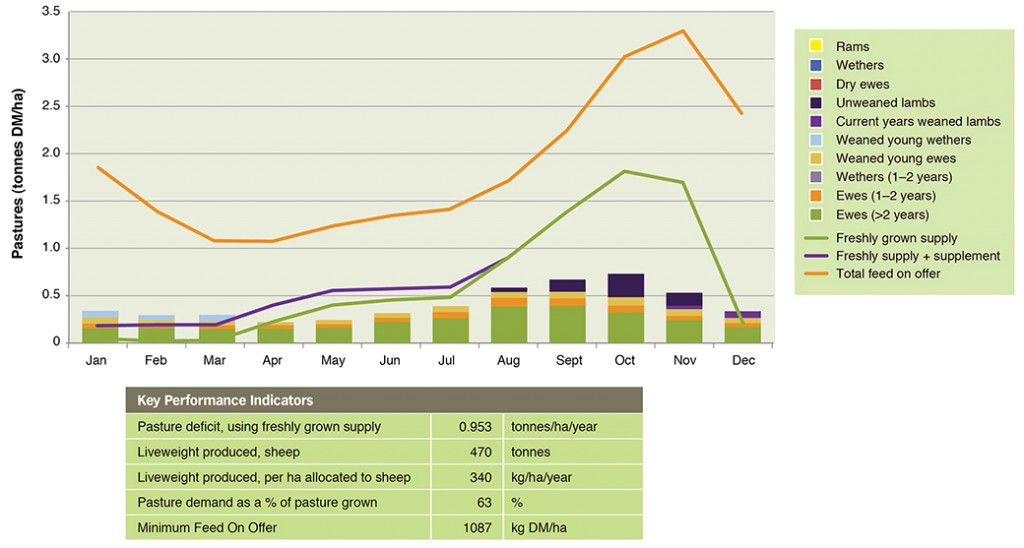
The important points from these examples are;
- Because there are less ewes and a lower stocking rate on the autumn lambing farm, the flock had lower pasture utilisation (37%) compared to the winter lambing flock (44%).
- Minimum Feed on Offer (FOO) was similar on both farms (900 kg/ha).
- Minimum green FOO for the autumn lambing ewes during mid-lactation was below optimum levels meaning either additional supplements were required or lamb growth rates would be penalised.
- With a late autumn break and no pasture growth in April-May, the cost of supplements for an autumn lambing flock will be much higher than for winter lambing ewes.
2. Seek information on likely pasture growth
There are several programs or tools that predict pasture growth based on current soil moisture, rainfall patterns and sea surface temperatures. While not perfect, these programs provide a check on the chances of different pasture growth scenarios in the next few months.
The MLA has a program called the “Rainfall to pasture growth outlook tool”. Example printouts are shown in Figure 3. Three faint dotted grey lines indicate the growth that is expected in the best 10% of years, median years and the worst 10% of years. Pasture growth is presented in two ways; weekly pasture growth or accumulated pasture growth to the current date shown in relation to the best, worst and median values. The red shaded area shows the likely growth in the next three months.
In this scenario, the graphs highlight the very low total growth up to July but that growth rates were predicted to be at least average for the remainder of the year. However, as shown in the Accumulated Pasture Growth graph, total pasture growth for the year was likely to be well below average.
Further explanation of the Rainfall to Pasture growth simulations are provided on the MLA website.
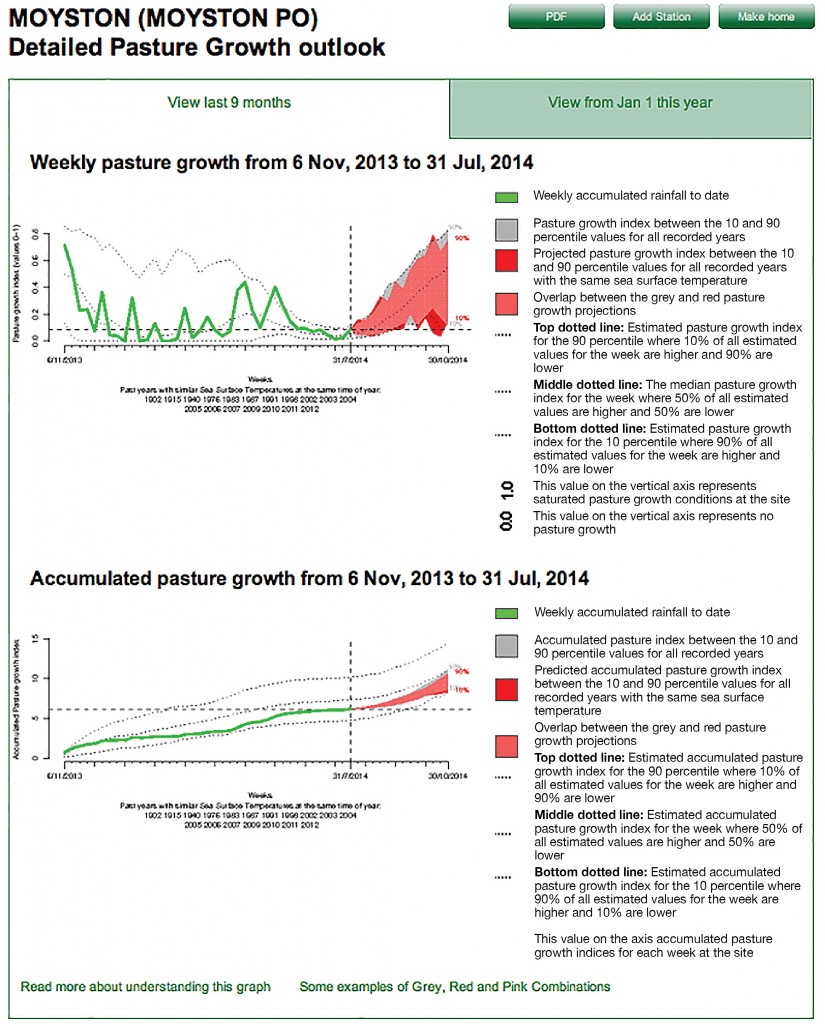
3. Work out the likely pasture surplus/deficit
The EverGraze Feedbase Planning and Budgeting Tools can be used to work out the likely Food On Offer (FOO) during winter making different assumptions about pasture growth and feed intake. Use the Winter Feed Budget sections to determine the size of the deficit or the amount of surplus feed.
4. Options for a tough autumn-winter
Poor growth in late autumn and winter can be due to either a late autumn break and/or very wet waterlogged conditions in mid-winter. Options to boost pasture growth or reduce feed demand include;
- Grow as much as you can, (rotational grazing, N fertiliser, Gibberellic acid (GA) application),
- Use benchmarks for ground cover based on slope and soil type, to de-stock areas to avoid long-term pasture damage and allow greater pasture growth when the opening rains occur,
- Sell low priority stock,
- Don’t mate some stock; ie ewe lambs or older ewes.
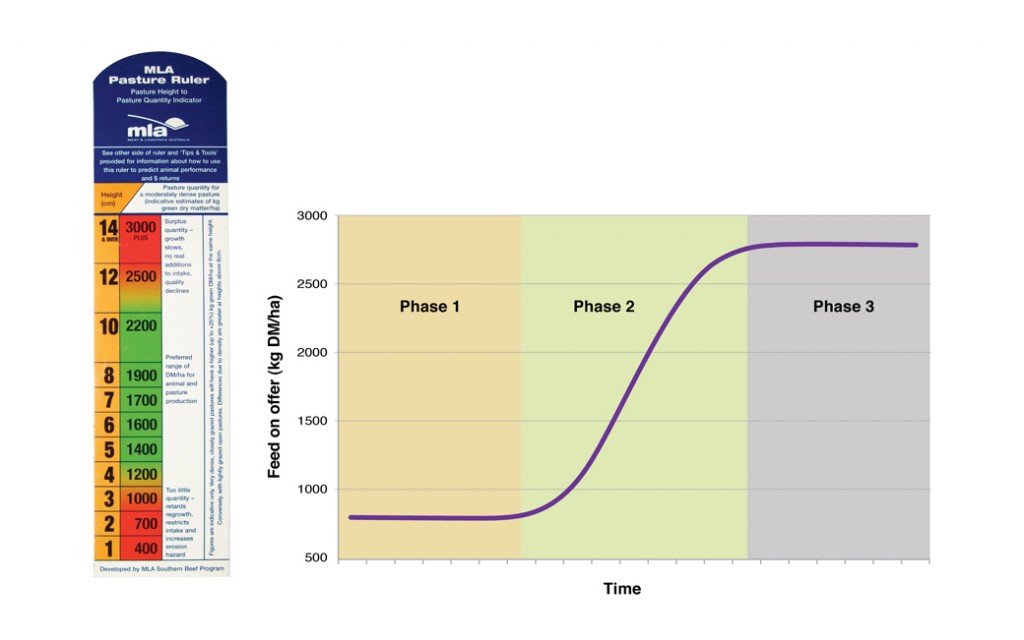
4.1 Grazing management for maximum growth in a tough autumn-winter
Pasture growth is higher if pastures have a greater leaf area.
When pastures are heavily grazed in autumn and winter and FOO values are continually between 500-700 kg/ha, growth rates can be 10-20% less than when pastures are allowed to reach 1200-1500 kg/ha prior to grazing back to 600-800 kg/ha.
In a tough year, every kg of pasture is important so strict rotational grazing is the best option.
Ideally, allow 40-50 days or for plants to reach the 3 leaf stage (ryegrass) or 4 leaf stage (fescue, phalaris, cocksfoot) prior to grazing.
Grazing should be for a maximum of 5-10 days.
Key points are;
- If the minimum thresholds for your soil/topography have been reached across the farm, take the stock off the paddocks and place in stock containment areas. This will limit damage to the perennials and allow quicker recovery once rain occurs. Stock in a bare paddock use extra energy walking around looking for feed!
- With a late break, autumn may not exist and stock may be in feedlots until June or until 600-800 kg/ha is available in the first paddock in the rotation.
- Once this target has been met, use a slow rotation to graze paddocks from say 800 down to 600 kg/ha. Supplements or growth promotants (nitrogen, GA) will be required to make the available pasture last so that the paddocks are spelled for 40+ days before grazing.
- Manage the rotation to gradually allow FOO to build up to about 1200 kg/ha by lambing.
- Rotational grazing will also encourage uniform grazing and stock will eat pasture that may otherwise be ignored ie on south facing slopes, leading to a 10-20% improvement in pasture utilised.
4.2 Nitrogen fertiliser
Dairy farmers commonly boost winter pasture growth with Nitrogen (N), but it is not widely used by sheep and beef producers. However, when feed is short in winter, it can be cost effective depending on the response in extra pasture per kg N applied and cost per unit of N. Note that responses to N fertiliser are highly dependent on soil temperature, season and pasture species.
Results from Warrnambool in western Victoria showed responses of 12-17 kg DM/kg N when in autumn when soil temperature was 120C, 7-15 kg DM/kg N in winter when soil temperature was about 80C and 23 kg DM/kg N in spring when temperatures were about 110C. At the same time and location, pastures with less responsive species and lower soil fertility grew at 7-8 kg DM/kg N, 6-7 kg DM/kg N and 17 kg DM/kg N respectively.
To get the best response to N, it should be applied to fertile improved pastures containing ryegrass, phalaris, cocksfoot or tall fescue. It is also vital that other nutrients especially potassium, sulphur and phosphorus are not limiting.
If any of these are deficient, then the response to N will be greatly reduced.
- On beef and sheep properties, expect about 7 kg of additional pasture per 1 kg of N applied in winter.
- Assuming that urea costs $650/tonne spread and contains 46% N, it will cost $46/ha to apply 70kg/ha of Urea or 32 kg/ha N.
- Assuming 7 kg pasture per kg N, an additional 230 kg/ha pasture should be grown. Assuming 80% utilisation, it means 180 kg/ha of pasture consumed at a cost of $46/ha or 25c/kg pasture.
- Assuming the fresh pasture contains 11.5 MJ energy/kg, using urea works out to 2.2c/MJ.
- In most comparisons, applying N will be more expensive than GA but slightly cheaper than using grain or hay. See Table 1 or use the EverGraze tool for comparisons.
The key to getting the most out of nitrogen fertiliser is:
- Apply to very responsive pastures. Aim to get 10 kg pasture/kg N rather than 7kg/N
- Apply to paddocks with 100% green cover of with 600-800 kg/ha dry matter on offer
- Use intensive rotational grazing (30-40 day rest) following N application to improve utilization.
4.3 Gibberellic Acid (GA) sprays
Gibberellic Acid (GA) is a naturally occurring plant hormone that plants produce in early spring which increases cell size resulting in leaves and stems becoming longer and wider. On farms, an artificially produced version can be applied with a boom spray to trick plants into commencing spring growth during winter.
Figure 5 shows a typical response in southern Victoria. It is important to differentiate GA from the many “mystery” liquid fertilisers that claim benefits but with no documented results. There is a body of evidence on the benefits of GA on winter pasture growth.
Figure 5. Effect of 15 g/ha Gibberillic Acid on perennial ryegrass pasture in western Victoria 2011
|
|
|
GA works best in the following situations;
- Growth is low due to cold, overcast weather and when pastures are growing at 5-10 kg/ha/day.
- Best responses occur with grass dominant, perennial pastures, but annuals will still respond.
- Better responses on phalaris than perennial ryegrass.
- Soil fertility must be adequate, for example 10-12 Olsen P or 25-30 Colwell P.
- When the sprayed paddocks are spelled from grazing for about 2-3 weeks.
- There is a possible trade-off with less spring growth in pastures treated with GA. Experimental results show variable impacts on spring growth, some experiments show a significant reduction, others no effect. For the costing below, it is assumed there is no reduction in spring growth because for most people, lower spring production is not critical.
- Apply GA in late June- early July so that extra pasture is available from mid-July when demand from lactating stock is high.
- Maximum responses occur about 3-4 weeks after application and will continue for another month. Apply 10-20 g/ha, use higher rates for ryegrass and lower rates for phalaris.
- The current price for GA is about $0.72/g. Assuming 15 g/ha is applied and the cost of application is $10/ha, overall cost is $20/ha applied.
- Pesticides and weed control can be combined with a GA application, but always seek specialist advice before combining any other chemicals with GA.
- Some people add 20-30 l/ha of Nitrogen as “Easy N” to GA. The effects appear to be additive, with the combined pasture growth higher than either GA or liquid N on their own. However, Easy N is quite expensive.
- GA will make the paddocks go yellow. Don’t be alarmed! They are still growing. However, liquid N removes the yellowing, as well as promoting additional dry matter.
- Based on a range of experiments, application of 15g/ha GA should provide about 350 kg/ha extra pasture assuming the GA is applied based on the earlier points.
- Of the 350 kg/ha grown, about 280 kg/ha will be consumed by stock (80% utilisation). Assuming a cost of $20/ha applied and pasture at 11.5 MJ/kg PM, GA works out at 7c/kg of pasture or 0.6c/MJ.
- Some people claim the additional growth from GA is only water. Extensive testing of GA treated paddocks has shown no change in ME, protein or water content.
- The response to GA seems to decline further north into NSW as winter daylight and average temperatures increase. Either seek out local experience or try GA on a small strip or paddock so you know how it will work and what to expect. Leave some untreated strips in each paddock so you can estimate the effect on your farm.
| EverGraze has developed a simple spreadsheet, available in tools, that allows comparisons of the costs and returns of using Nitrogen, Gibberellic Acid or supplementary feed to overcome pasture shortages in winter and spring. |
4.4 Supplements to overcome feed shortages
Supplementary feeding is the usual way to deal with pasture shortages throughout the year. It is important that feedstuffs are compared on an energy consumed basis. Feeds vary in moisture content, energy content (MJ/kg), cost/tonne, and utilisation in the paddock. Low utilisation (high wastage) can occur either because the sheep/cattle cannot pick up the supplement, trample some into the ground or because they do not efficiently digest whole grain.
Hay, silage and grain are purchased on an “as is” basis and so moisture content must be considered. Some examples for different feeds are shown in Table 1. However, it is important especially when buying supplements, to use FeedTest analysis to accurately compare feeds.
Table 1. Estimated cost per Megajoule (MJ) of typical supplements.
| Feed type | Dry Matter content % | Average ME MJ/kg | Average ME as fed MJ/kg | Assumed cost $/tonne | c/MJ as fed | Utilisation in the paddock | $/MJ consumed by stock |
| Oats | 90% | 10.4 | 9.4 | $200/t | 2.1/MJ | 80% | 2.6c/MJ |
| Hay | 85% | 8 | 6.8 | $150/t | 2.2/MJ | 80% | 2.8c/MJ |
| Wheat | 90% | 13.1 | 11.8 | $180/t | 1.5/MJ | 70% | 2.1c/MJ |
| Silage | 60% | 9.5 | 5.7 | $120/t | 2.1/MJ | 85% | 2.5c/MJ |
| Nitrogen winter | 2.2c/MJ | ||||||
| Nitrogen spring | 1.0c/MJ | ||||||
| GA | 0.6c/MJ |
To work out the cost of supplements on a dry matter basis and per MJ;
- Multiply the Metabolisable Energy (ME) MJ/kg by dry matter content; 10.4*90% = 9.4 MJ ME/kg dry matter
- Divide the cost/kg ($200/t = 20 cents/kg) by the MJ ME/kg dry matter; 20/9.4 = 2.1 c/MJ as fed
- Divide the cost per MJ as fed by utilisation factor; 2.1/0.8 = 2.6 c/MJ
5. Spring feed shortages
In some years, spring pasture supply can be low especially if there has been a tough winter. However, it is possible to boost pasture growth in September – early October while there is still available soil moisture and so try and catch-up to normal seasonal conditions.
Nitrogen fertiliser can be applied in early spring (August – September) before the pasture transpires the moisture in the soil. In the warmer spring conditions, there are responses of 15-20 kg pasture per kg N applied. Estimated returns from using N in spring are;
- Assuming that urea costs $650/tonne spread and contains 46% N, it will cost $46/ha to apply 70 kg/ha Urea or 32 kg/ha N.
- Assuming 15 kg pasture per kg N, an additional 480 kg/ha pasture should be grown. Assuming 80% utilisation, it means 380 kg/ha of additional feed eaten at a cost of $46/ha or 12c/kg pasture.
- Assuming the fresh pasture contains 11.5 MJ energy/kg, using urea in spring works out to 1c/MJ.
- If valuing the additional pasture as hay, it means that you have to be able to sell the hay for at least $150/tonne to be profitable.
- GA does not work in spring when temperatures and sunlight are adequate for pasture growth.
6. Summer- autumn feed deficits
To have sufficient dry feed to last over summer, about 3000 kg/ha is required when pastures dry off at the end of spring (November-December). This figure seems to work in most locations regardless of rainfall and stocking rate.
In regions with higher rainfall and higher stocking rates, pastures dry off later in spring (December) and start growing earlier in autumn. So although there are more stock per ha, the dry period is relatively short. In drier regions with lower stocking rates, pastures dry off earlier (October) and the dry pasture period is longer so the dry feed needs to last longer!
It is important to balance using (eating) the dry feed with protecting the pasture resource.
The steeper the topography and the lighter the soils, the greater ground cover is required to avoid soil and pasture degradation.
Paddocks that have been spelled from grazing in autumn will get away faster after the opening rains as plant reserves will have been maintained. Therefore, additional feed used to maintain the stock in the containment area will be balanced by a shorter period of feeding after the break.
Table 2 shows suggested minimum ground cover and FOO levels for different soils and topography. Once these minimum ground cover or FOO values are reached in summer or autumn, it is better to destock the paddocks and feed livestock in containment areas. Information about setting up these areas can be found on the NSW DPI Prime Facts 554 Confinement feeding of cattle in a drought.
Table 2. Recommended minimum FOO for different soils and topography

Special purpose summer pastures
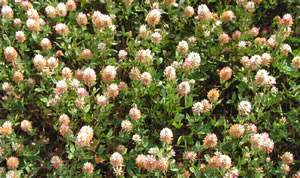
Summer crops (rape, turnips etc) can provide feed in summer but the lower the rainfall, the less reliable these are. Often, the years when summer feed is most needed are when late spring and summer rainfall is below average and so summer crops provide little or no feed.
A better alternative in many broad-scale sheep and cattle regions is to use species that make the most of the conditions in late spring and can then hold the quality feed for 1-3 months.
Effectively, spring feed is transferred into summer. Lucerne, chicory or kikuyu can all be used to carry feed into summer and can also respond to summer rain. Spring grown herbage will maintain quality for 1-2 months but leaf fall can occur in early summer under very hot conditions.
Arrow leaf clover is a unique annual species that grows in late winter and early spring, dies off in late spring but then retains quality well into summer. Effectively, it is a haystack in the paddock.
Figure 6 shows the nutritive value of Arrow leaf clover cv Arrotas compared to Leura sub clover.
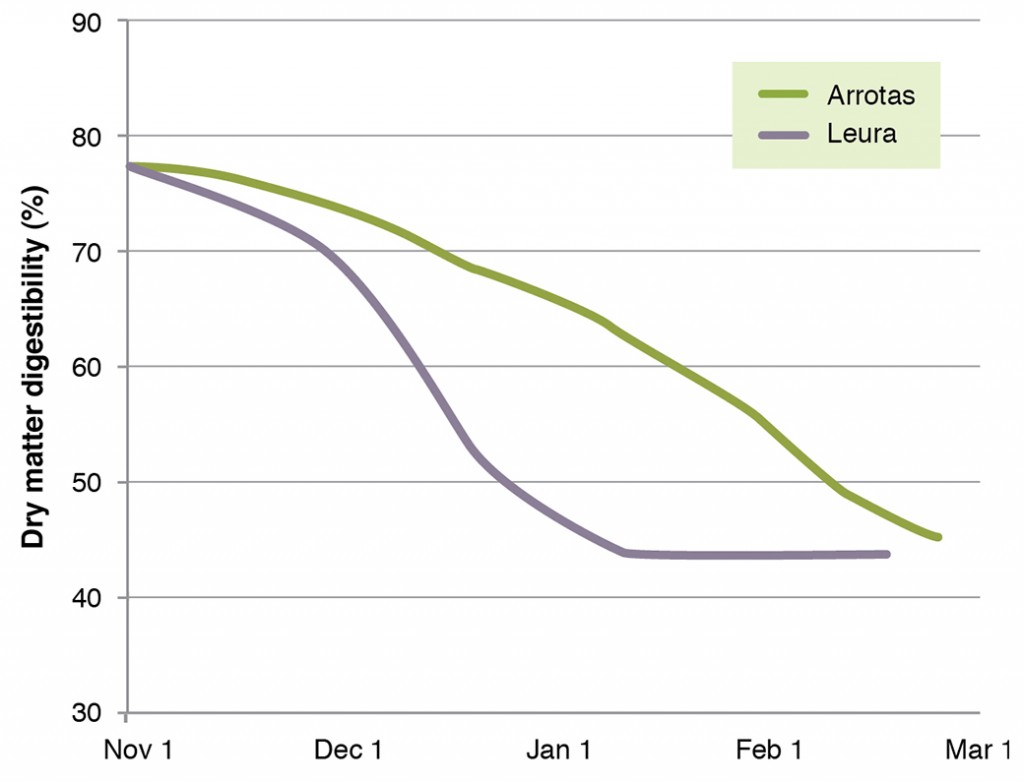
7. Reducing stock numbers on the farm
Sell stock
- Every farm should have 1-2 mobs of sheep or cattle that are discretionary and can be easily sold if conditions get tough.
- Work undertaken at the Wagga Wagga EverGraze Proof Site identified Split Joining as a way to deal with failed springs in a region with widely variable seasons. In a tough year, early born lambs can be weaned and sold. In a drought, both ewes and lambs can be sold. In a good season, the early born lambs can be carried through to heavier weights.
- Draw up a list of stock that can go and sell them before they lose condition. The earlier surplus or low priority stock are sold the better the price and the greater reduction in grazing pressure on the farm. Waiting until stock lose condition and markets fall compounds the loss.
Agistment
- Putting stock, especially cattle, onto agistment is very attractive when parts of the country are having a good year and other areas are doing it tough. In northern Victoria, about $5 per cow per week, $6.50 for cows and calves, $3.50 young cattle and $0.50 for ewes and lambs are common rates. In addition to the weekly cost, transport costs need to be added.
- A complication with agistment is the quality and availability of feed. Many of the agistment pastures in central NSW are summer active native pastures, such as red grass. These are lower in ME/Kg than temperate perennials, so don’t expect the same growth and milk production as equivalent pastures in Victoria.
- At $6 per cow per week (including transport costs), this would buy about 30 kg grain or 4.5kg/day. This amount of grain will provide about 54 MJ energy/day or 66% of a cow’s total requirements of about 80 MJ/day.
- Consider if the cost of feeding is going to be greater than the cost of paying for agistment.
- If some stock are sent on agistment, it may mean other stock will not need feeding.
8. What to do in a good year
In a good year when there is surplus feed, often people don’t take advantage of the situation. This might be the right response but options to use the bonus feed should be considered. These include;
- Make sure your stock eat as much as possible and transfer the pasture into body condition. Set stocking will allow highest intake. Don’t limit intake (but avoid over-fat heifers).
- Take stock on agistment but be aware of quarantine issues.
- Keep stock that might otherwise be sold
- Make opportunistic decisions, ie Join stock that would normally be dry, ie weaner lambs joined at 7-8 months is one way to use more pasture and increase stocking rates in a good year.
- Take the opportunity to renovate pastures (spraytop, spray graze). These practises reduce pasture growth in the year of treatment but this does not matter when there is surplus feed.
- Sow more crops. Allow contractors to put crop in.
- Sow new pastures.
- Allow pasture to decay and add organic matter to the soil.
- Conserve forage as hay or silage.
- There is a market for hay for export and the dairy industry so can be a profitable way to use surplus feed. However, the cost of nutrients exported with the hay, especially Potassium and lime must be realised.
- Storing hay or silage on farm as a drought supply is another obvious alternative. However, make sure that the fodder is stored correctly to avoid damage from moisture, rodents, fire etc. There is no point storing fodder for the long haul if it deteriorates before it is used.
- Loss of nutritive value in storage is directly related to the quality of the material stored. High quality legume dominant hay deteriorates at a greater rate than lower quality grass hay. Insects, bacteria and microorganisms like high quality hay just as sheep and cattle do. For long term storage, aim for good quality grass hay rather than putting sub clover or lucerne hay into long term storage.
Understanding beef cattle requirements
Sheep are much more selective grazers than cattle. It means that on a pasture with a mixture of green and dead pasture or low and high quality plants, sheep can more easily select out the good bits and leave the lower quality material and so the stock grow to their potential. However, it also means that the sheep put the desirable (usually sown) species under pressure which combined with the low harvest height can over time, weaken the desirable plants.
Cattle consume the pasture more evenly and are not as selective for the higher quality material. Therefore, when there is a lot of low quality material in the pasture, cattle growth will be reduced more than for sheep. The effect of pasture composition on the growth rates of beef cattle at Hamilton is shown in Figures 7 and 8. In winter/spring, when there is more than 1200 kg/ha green pasture, the more dead pasture present, the LOWER the weight gain.
Growth rates of 0.6 to 0.8 kg/day occurred when there was 2000 kg/ha green and only 500 T/1000 ha dead pasture. In summer to autumn, if the pasture has 1000-3000kg/ha dead pasture and more than 600 kg/ha green pick, steers will gain around 0.3-0.4 g/day. However, if there is <500 kg/ha or >4000 kg/ha dry pasture, growth rates of cattle will be much lower than for intermediate levels of dry pasture. Many producers are reluctant to feed grain due to apparent wastage with whole grain visible in dung.
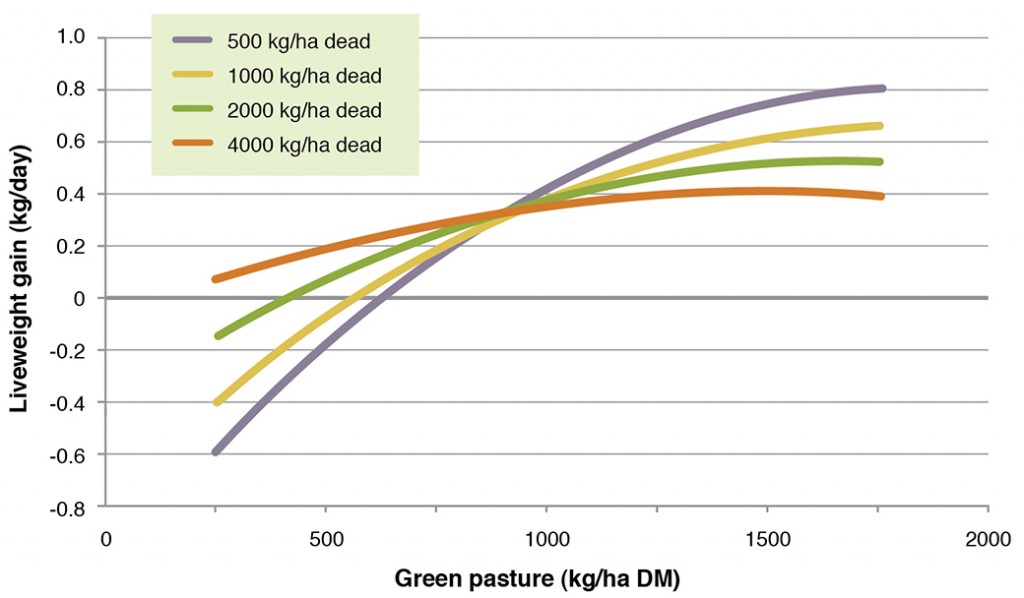
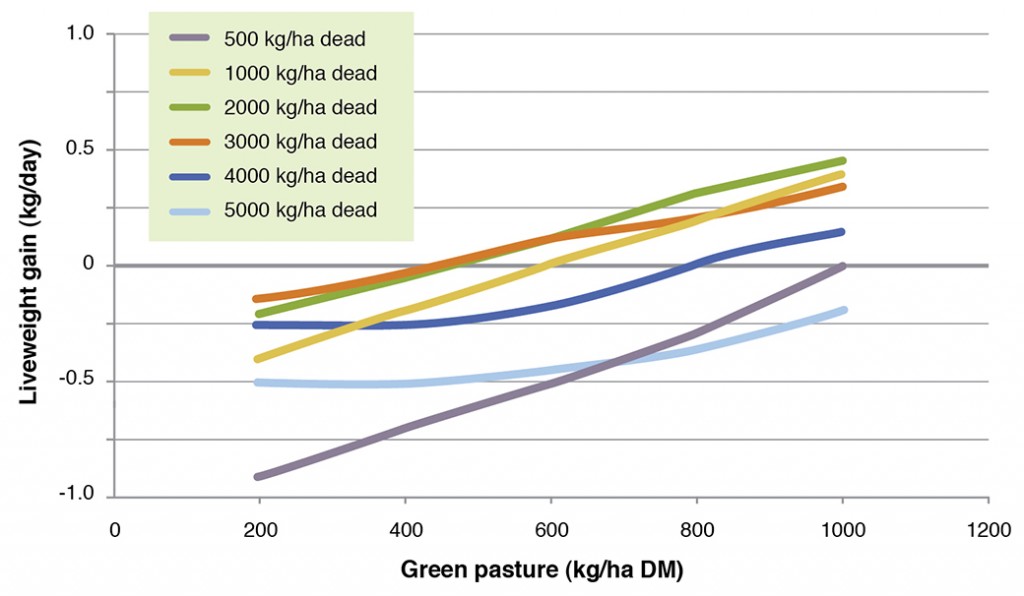
However, in drought situations, grain is commonly and successfully fed to cattle.
NSW DPI Primefacts 275 written by Bill McKeirnan provides good information especially on the value of crushing versus feeding whole grain commenting;
“For full drought feeding of cattle, it is preferable to feed grain whole rather than processed. Processing makes grain more digestible but when there is no roughage this can cause problems. There will be wastage with whole grain, but this is cheap insurance”
Other issues with processed grain are wastage when rolled grain gets wet, difficulty in handling rolled/crushed grain and the additional cost of processing. Much of the apparent whole grain in dung is actually partly digested. Table 3 provides an example of the drought ration for cattle. An example of feeding hay or whole oats to young cattle is shown in Table 4.
Table 3. A typical introductory regime for increasing grain content in a complete ration for cattle
| Day | % in ration | |
| Cereal | Hay | |
| 1-5 | 20 | 80 |
| 6-10 | 40 | 60 |
| 11-15 | 60 | 40 |
| 16-20 | 70 | 30 |
| Final ration | 80 | 20 |
Table 4. Effect of feeding hay or grain in summer-autumn on live weight and efficiency of conversion of energy to liveweight.
| Parameter | Pasture only | Oats fed at 0.8% of liveweight | Oats fed at 1.6% of liveweight | Lucerne hay fed ad lib | Pasture hay fed ad lib |
| Weight gain January-May | 13 kg | 51 kg | 85 kg | 72 kg | 35 kg |
| Supplement intake kg | 0 | 230 kg | 460 kg | 726 | 278 kg |
| ME MJ/kg | 12.5 MJ | 12.5 MJ | 10.6 MJ | 8.1 MJ | |
| Conversion ratio Kg Supplement/Kg LWG |
6.0:1 75MJ/KG |
6.4:1 80MJ/KG |
12.3:1 130MJ/KG |
12.6:1 102MJ/KG |
|
| Cost per kg LWG Oats $200/t, Pasture hay $150/t Lucerne hay $200/t |
$1.20/kg LWG | $1.30/kg LWG | $2.40/kg LWG | $1.90/kg LWG |
These results highlight the superiority of feeding grain compared to hay to cattle in summer-autumn. When hay is used, cattle eat less of the dry pasture and substitution occurs. While oats is probably the grain of choice to use with cattle, even if wheat or barley was used with greater wastage, conversion efficiency could fall by nearly 50% but still match that achieved with hay.
Compensatory gain
Hay is commonly fed to cattle in winter when FOO levels are low. Research undertaken in the 1970’s (Figure 9) questioned the value of supplementing cattle in mid-winter compared with feeding to generate a feed wedge in autumn.
In this example, the hay was relatively low quality (Digestibility 57%, 7.2ME MJ/kg dry matter) but this is typical of hay fed to cattle in winter. The results show that feeding the hay in autumn to allow pasture to get ahead was the best option rather than waiting until cattle lost weight in winter. Also note how non-supplemented cattle caught up to the cattle fed hay due to compensatory gain during spring.
